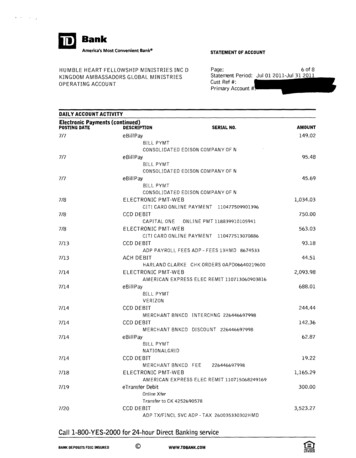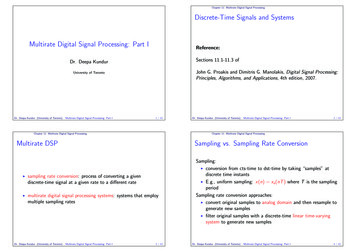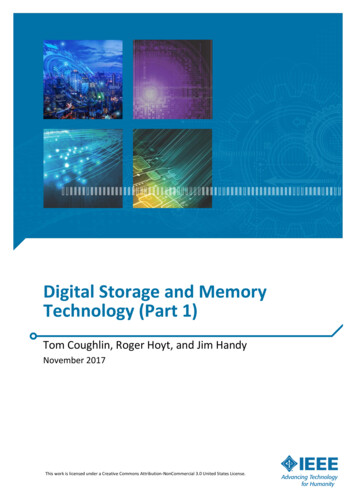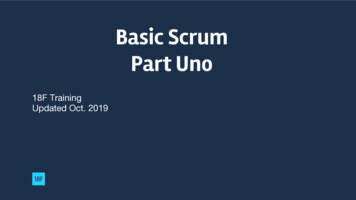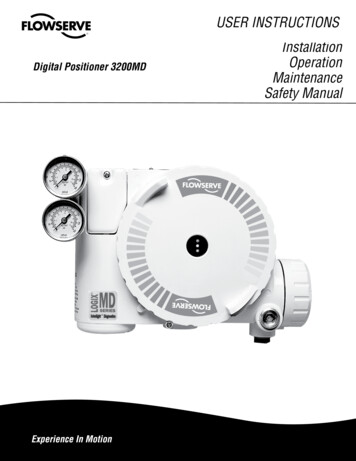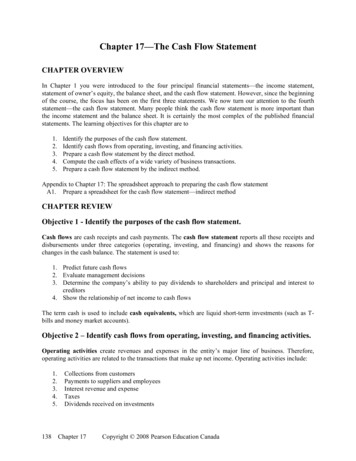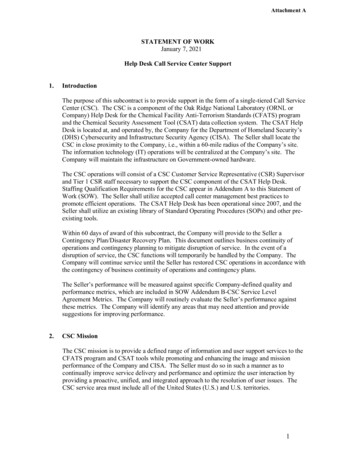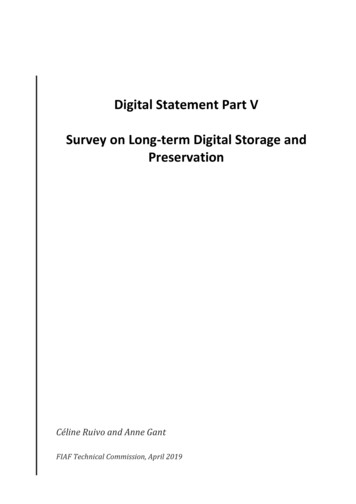
Transcription
Digital Statement Part VSurvey on Long-term Digital Storage andPreservationCéline Ruivo and Anne GantFIAF Technical Commission, April 2019
Digital Statement Part V / Survey on Long-term Digital Storage and PreservationTable of contentI.INTRODUCTION: EXISTING REFERENCES AND RESOURCES . 2II.“RAW UNCOMPRESSED FILES” OR “RAW SCANS” . 4III.MASTER FILES. 6IV.PROJECTION, ACCESS, DISTRIBUTION . 7V.NEW FILMS, NEW ACQUISITIONS . 8VI.SOUND PRESERVATION . 10VII.LONG-TERM STORAGE . 10VIII.ACCESS STORAGE . 12IX.COLLECTION MANAGEMENT . 14X.RECORDING RESTORATIONS BACK TO FILM . 15XI.CONCLUSION. 161
Digital Statement Part V / Survey on Long-term Digital Storage and PreservationI.Introduction: Existing references and resourcesThe sustainability of digital files and formats for long-term preservation has been a majorconcern in our field for almost two decades now. The FIAF Technical Commission publishedthe Digital Preservation Principles in 2016, taking as its reference the OAIS (Open ArchivalInformation System) Model, which is available online.1Increasingly, film archives are publishing their own technical specifications online for thedeposit of digital elements, such as the Swedish Film Institute.2 The Digital Dilemma, publishedin 2007 by the Academy Film Archive of the Academy of Motion Picture Arts and Sciences3,also contains valuable information and recommendations for the transition from analog todigital, including recording data on film, which is still a sustainable way to preserve the filesand save films. Currently a European project on digital preservation is being written inGerman.4The FIAF website additionally contains valuable links and resources about digitalpreservation.5The present text intends to provide an overview of the different practices of digital preservation,according to the results of a small survey sent by the Technical Commission to FIAF membersand correspondents in January 2019.Through institutional examples (bigger archives and smaller archives) this text intends to drawa landscape of digital preservation in different locations. Also we have to notice that a fewarchives, such as the Cinemateca Portuguesa, Cinémathèque française, Cinemateca Brasileira,CNC, Cinémathèque suisse, Swedish Film Institute and EYE, are still practicing “emergencyphotochemical duplications” in order to make one duplication of unique film elements in a stateof advanced deterioration6 or regular 35mm prints for film elements. These archives, includingthe BFI, also consider that it is still possible to make restorations purely on film.7This survey is naturally not exhaustive, since it is not representative of the entire community ofarchives. Different archives will also have different choices according to clear preservation1Resource available on the TC page, FIAF website. Link: es/Commission-And-PIPResources/TC %200.pdf2Swedish Film Institute online specifications: of-digitalfilm-elements-oct-2015.pdf3The Digital Dilemma can be downloaded on this link: projects/digital-dilemma4DIN SPEC 15587: German recommendation for the digitization of film. There is a current project group todevelop a CEN standard for the preservation of digital FIAF-Summer-School-Resources.html6The Cinemateca Brasileira lab still processes photochemically, mainly via wet-gate 35mm film duplication.2018 processing statistics: photochemical duplication 93.303 metres; sound to digital files 86.696 metres;scanned images 37.574 metres. The financial perspectives of 2019 foresee an eminent reduction in filmduplication due to limitations on buying raw stock.7See the BFI Heritage 2022 print-making project (non-digital).2
Digital Statement Part V / Survey on Long-term Digital Storage and Preservationgoals, access goals, and budget limitations for storage. Nevertheless, it provides a sense of thestandards that have been applied by a sample set of institutions and commercial laboratories forthe past few years.Among the 17 non-profit institutions or private organizations that received the survey, 16provided answers. We would like to thank the following archives and persons who took part inthis survey:Film Archives-British Film Institute (BFI), London, UK, Kieron Webb and Stephen MacConnachieBundesarchiv, Berlin/Hoppegarten, Germany, Florian WrobelCentre national du cinéma et de l’image animée (CNC), Paris/Bois d’Arcy, France,Daniel BorensteinCinemateca Brasileira, São Paolo, Brazil, Rodrigo MercêsCinemateca Portuguesa, Lisbon, Portugal, Tiago Ganhão and Tiago BaptistaCinémathèque française (CF), Paris/Saint-Cyr, France, Céline Ruivo and YohannDedyCinémathèque Royale de Belgique (CRB / Cinematek), Brussels, Belgium, AriannaTurci and Bruno MestdaghCinémathèque suisse, Lausanne, Switzerland, Caroline FournierEYE Filmmuseum, Amsterdam, Netherlands, Anne GantImperial War Museums (IWM), London, UK, David WalshIrish Film Archive (IFI), Dublin, Ireland, Kasandra O’Connell and Kieran O’LearyLibrary of Congress (LoC), Washington, DC/Culpeper, Virginia, USA, HeatherLinvilleSvenska Filminstitutet / Swedish Film Institute (SFI), Stockholm, Sweden, LarsKarlssonTaiwan Film Institute (TFI), Taipei, Taiwan, Teresa HuangOther organizations-AV Preservation by reto.ch, Ecublens, Switzerland, Reto KromerSan Francisco Silent Film Festival (SFSFF), San Francisco, USA, Robert Byrne3
Digital Statement Part V / Survey on Long-term Digital Storage and Preservation“Raw uncompressed files” or “Raw scans”II.As mentioned in Part II of the Digital Statement, digitizing a film includes not only archivinga final result (the master), but also archiving what are commonly called the “raw files” (imageand sound),8 which are uncompressed. 14 of the archives that answered the survey use anoverscan for the image during digitization, which includes part of the edges and the frameline.According to the possibilities of the scanner, the Cinémathèque française (CF) and the CNC,for instance, are practicing the full overscan, which includes the entire film edge informationwith the manufacturer’s signature and edge codes, or the entire perforation shape.The Cinémathèque Royale de Belgique (CRB / Cinematek) has chosen not to keep the rawscans, and mostly archives the master files.1) Image / Output Format: DPX or TIFF 9-DPX is the main format used for preservation: 14 archives-TIFF is used as a second preservation format: 4 archives (CNC, Bundesarchiv, IFI,Cinémathèque suisse).4 archives in the survey (Cinémathèque suisse, IFI, CNC, Bundesarchiv) are using both nativeformats,10 depending also on the source material (DPX for negative or TIFF for positive stock).2) Logarithmic vs. Linear / bit depth10 bit Log DPXs are used in most cases, although in single cases, 12 bit Log and 24 bit Log.TIFF only supports linear color space, and is used in most cases in 16 bit.For DPX formats:- RGB 10 bit Log: 10 archives- RGB 12 bit Log: 2 facilities (AV Preservation, Cinemateca Portuguesa)- RGB 16 bit Lin: 1 archive (Bundesarchiv)- RGB 16 bit Log: 1 archive (BFI)- 24 bit Log: 1 facility (AV Preservation)- Single-channel 10/12 bit Log: 1 archive (BFI)For TIFF formats:-16 bit Lin: 4 archives (Bundesarchiv, CNC, IFI, Cinémathèque suisse)Digital Statement Part II: “Raw Scans”.For further information on DPX and TIFF, or questions associated with Log, Lin, and bit rate, please visit thefollowing website, which provides a useful and simple glossary of ides/what-file-format-should-i-scan-my-film10Since DPX can be converted into TIFF during post-production.894
Digital Statement Part V / Survey on Long-term Digital Storage and PreservationThe IFI mentions that using 16 bit Lin TIFF goes with their scanners’ settings and output. TheCNC and Cinémathèque suisse use 16 bit Lin TIFF for scanning 35mm positive prints withhigh contrast, but 10 bit Log for 35mm negatives.Depending on their 3 scanners, the Cinemateca Portuguesa won’t do the same native output:Cineric scanner: DPX, 4K wet-gate, 12 bit Log; Blackmagic scanner: DPX, ultraHD, dry, 10bit; MWA scanner: ProRes 422 HQ, HD. Two scanners are being used for collection access,and not for preservation.The Bundesarchiv also uses 16 bit Lin DPX because they are scanning films not only for accessbut also for preservation, and opted for higher quality (or a higher amount ofdata).Depending on the project, the BFI uses 10/12/16 bit Log. For black & white films they set thescanner to a single channel (monochrome), which helps to reduce the overall size of the rawscans.3) Resolution2K and 4K are the main resolutions used today for scanning. Depending on the film stock,gauge, material, type of scanner, or the final result (preservation or access), a choice ofresolution can be applied.2K: 8 archives3K: 1 archive (Cinemateca Brasileira)4K: 8 archives6K: 1 facility (AV Preservation)8K: 2 facilities/archives (AV Preservation, CF).For instance, 2K resolution is applied by 6 institutions11 when they scan a 35mm positive or16mm film or even smaller formats (CNC, CF, LoC, EYE, SFI, Bundesarchiv).Most of the survey archives use 4K resolution when they scan 35mm negatives, even thoughsome archives have chosen to scan both 35mm negatives or original nitrate positives in 4K forpreservation purposes. 16mm can also be scanned at 4K at the Cinémathèque suisse, dependingon the source. 8K resolution has been applied at the CF to wide formats or obsolete gauges suchas 90mm. The CNC has scanned 75mm Lumière films at 7500 pixels.The Cinemateca Brasileira uses a certain type of resolution, depending on the original material;the geometry varies, from “full aperture” (for silent films) or “Academy” (for sound films).35mm film is mainly scanned at the Arriscan “native” 3K resolution (silent 3072 x 2106, sound2730 x 2075) and framed so that the perforations can be used as a future reference for imagestabilization. 16mm film is only scanned using the Cintel Ditto at 1728 x 1232. No “super16mm” was scanned last year.11For those who provided a precision.5
Digital Statement Part V / Survey on Long-term Digital Storage and PreservationIII. Master FilesMaster files are commonly a second version of the raw scans, which have been graded andrestored (see Part III of the Digital Statement). Usually Master files are also cropped, comparedto raw files, which are made in overscan to keep the edge information and for restorationtreatment purposes.12 Cropping makes them suitable for projection with the proper aspect ratio.They can be converted (DPX to TIFF, or Log to Lin) depending on needs and final output.In some cases, such as at the IWM, digitization is mostly done for access, research, and TV use.Most of the films are not graded or restored, and are already cropped. In this case the raw scansand master files are the same version; they are also regarded as access files by the institution.The Cinemateca Brasileira, for instance, has been preserving three versions of the master: therestored files and the graded files are stored separately, with the final result, including both,being the third version.1) The Color SpaceThe CNC, BFI, and Swedish Film Archive and EYE mentioned that the color space of thedigital master is set usually at DCI-P313 or Rec. 709.2) Resolution, bit rateMost of the responding archives use the same resolution or formats as the raw scans in order tocreate a master.The CNC converts 4K files to 2K in order to create a master.3) Mezzanine8 archives have implemented a Mezzanine format. This compressed file is made from themaster files, and is useful and flexible enough to generate access files for streaming or VoD,forinstance. But it is not yet considered a long-term preservation format. This survey demonstratesthat the responding institutions do not use a format according to any specific standards.“Mezzanine” seems to be an unclear terminology in archival practice, since in some cases,lossless compression for long-term storage (see the section below dedicated to storage) and thenotion of Mezzanine in the industry world appear to be the same thing. One example is the IMFformat, which is a lossless JPEG 2000 compression (reversible) and an SMPTE standardrecommended to produce a Mezzanine file.1412The overscan also helps the work on stabilization made on softwares. The perforations can be a reference forproper stabilization work that respects the original movement of the film.13DCI-P3 is a common RGB color space set for digital movie projection.14The French cinematographers association (CST) recommends the use of IMF, SMPTE ST 2067-40, asmezzanine format: t021-imf/6
Digital Statement Part
deposit of digital elements, such as 2the Swedish Film Institute. The Digital Dilemma, . -EYE Filmmuseum, Amsterdam, Netherlands, Anne Gant -Imperial War Museums (IWM), London, UK, David Walsh -Irish Film Archive (IFI), Dublin, Ireland, Kasandra O’Connell and Kieran O’Leary -Library of Congress (LoC), Washington, DC/Culpeper, Virginia, USA, Heather Linville -Svenska Filminstitutet .
